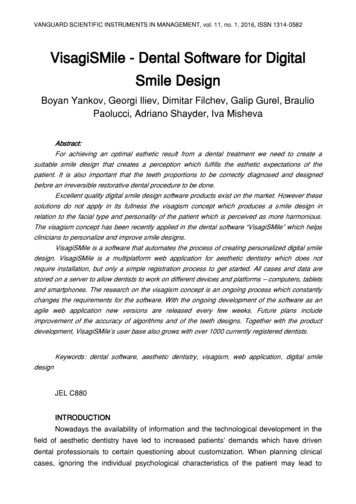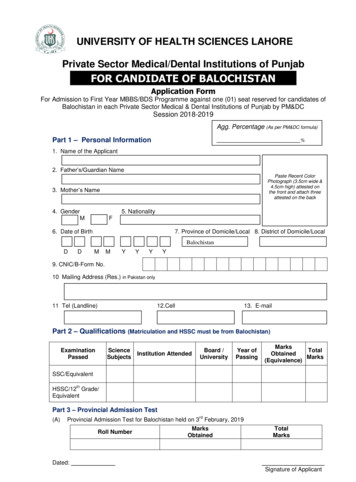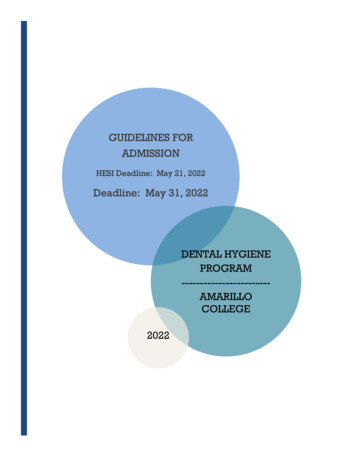
Transcription
VANGUARD SCIENTIFIC INSTRUMENTS IN MANAGEMENT, vol. 11, no. 1, 2016, ISSN 1314-0582VisagiSMile - Dental Software for DigitalSmile DesignBoyan Yankov, Georgi Iliev, Dimitar Filchev, Galip Gurel, BraulioPaolucci, Adriano Shayder, Iva MishevaAbstract:For achieving an optimal esthetic result from a dental treatment we need to create asuitable smile design that creates a perception which fulfills the esthetic expectations of thepatient. It is also important that the teeth proportions to be correctly diagnosed and designedbefore an irreversible restorative dental procedure to be done.Excellent quality digital smile design software products exist on the market. However thesesolutions do not apply in its fullness the visagism concept which produces a smile design inrelation to the facial type and personality of the patient which is perceived as more harmonious.The visagism concept has been recently applied in the dental software “VisagiSMile” which helpsclinicians to personalize and improve smile designs.VisagiSMile is a software that automates the process of creating personalized digital smiledesign. VisagiSMile is a multiplatform web application for aesthetic dentistry which does notrequire installation, but only a simple registration process to get started. All cases and data arestored on a server to allow dentists to work on different devices and platforms – computers, tabletsand smartphones. The research on the visagism concept is an ongoing process which constantlychanges the requirements for the software. With the ongoing development of the software as anagile web application new versions are released every few weeks. Future plans includeimprovement of the accuracy of algorithms and of the teeth designs. Together with the productdevelopment, VisagiSMile’s user base also grows with over 1000 currently registered dentists.Keywords: dental software, aesthetic dentistry, visagism, web application, digital smiledesignJEL C880INTRODUCTIONNowadays the availability of information and the technological development in thefield of aesthetic dentistry have led to increased patients’ demands which have drivendental professionals to certain questioning about customization. When planning clinicalcases, ignoring the individual psychological characteristics of the patient may lead to
VANGUARD SCIENTIFIC INSTRUMENTS IN MANAGEMENT, vol. 11, no. 1, 2016, ISSN 1314-0582dissatisfaction, even when all the classical rules and established standards of aestheticsare being used.Concepts, techniques, and materials by which dentists establish new smiles withminimally invasive approaches and maximum natural effect on the restorations are appliedin aesthetic dentistry, in the same time restoring the mastication and phonetics to achievebetter quality of life. Besides the aesthetic rules established throughout time, the emotionalexpression of the treatments, represented by the shapes and lines constituent of a smile,should also be taken into consideration when creating a customized and personalizedtreatment plan.The concept of “visagism” can help dentists perform restorations that correspondnot only to the esthetic, but also to the psychological features of the created image, whichaffects the emotions, identity, behavior and confidence of the patient. On the other side,these factors affect the way the patients react to the definite treatment [13]. The visagismconcept has been recently applied in the dental software “VisagiSMile” which helpsclinicians to personalize and improve smile designs [17].DIGITAL PLANNING OF AESTHETIC DENTISTRY CASESFor achieving an optimal esthetic result from a dental treatment we need to create asuitable smile design that creates a perception which fulfills the esthetic expectations ofthe patient. [4] [12] It is also important that the teeth proportions to be correctly diagnosedand designed before an irreversible restorative dental procedure to be done. [3].Excellent quality DSD (Digital Smile Design) software products exist on the market,such as DSD 2D [5], Smile Designer Pro [15], Planmeca Romexis Smile Design [14].However these solutions do not apply in its fullness the visagism concept which producesa smile design in relation to the facial type and personality of the patient which isperceived as more harmonious. When creating a personalized smile design it is a goodpractice to apply the “visagism” concept [9].Visagism applied in aesthetic dentistry is associated with assessment of the facialtype, which usually involves subjective judgment, time consuming personality test andcomplex calculations of the teeth configuration. The numerical results are then visualizedas a teeth design crafted by hand, which served for the patient, for the dentist and for thedental laboratory.VisagiSMile is a software that automates the process of creating creatingpersonalized digital smile design. VisagiSMile is a multiplatform web application foraesthetic dentistry which does not require installation, but only a simple registrationprocess to get started. All cases and data are stored on a server to allow dentists to workon different devices and platforms – computers, tablets and smartphones. The researchon the visagism concept is an ongoing process which constantly changes the
VANGUARD SCIENTIFIC INSTRUMENTS IN MANAGEMENT, vol. 11, no. 1, 2016, ISSN 1314-0582requirements for the software [17].The process of creating clinical cases with VisagiSMile requires two mainphotographs: one of a full-face with maximal smile and visible dentition and another of theupper jaw with retracted lips and black contrasting tool. The photograph in full-face withmaximal smile and visible dentition uploaded in VisagiSMile is automatically placed behindthe facial frame. By marking the landmark points on the image, the software automaticallyanalyzes the facial structure and classifies the facial shape as strong, dynamic, delicate orcalm (Fig.1).Fig. 1 Facial map with landmark points and type classification.By analyzing the face, VisagiSMile can automatically calibrate the picture by usingthe pupils’ positions. The software also recognizes the facial features and creates a facialmap. The image recognition is performed with the help of Betaface API [1]. The facial mapis then used to classify the type of face of the patient. The software currently uses twomethods of classification: geometrical approximation and classification trees.The first method to automatically classify the patient’s face is by geometricalcomparison of the facial map with the typical maps for different types of faces – strong,dynamic, delicate and calm. This method assumes that all points and facial features fromthe facial map are important for the facial type. The algorithm was first trained by analyzing91 faces, classified by an expert dentist. The results of the training are typical facial mapsfor the different facial shapes which are stored in a database. When a picture of a patient
VANGUARD SCIENTIFIC INSTRUMENTS IN MANAGEMENT, vol. 11, no. 1, 2016, ISSN 1314-0582is uploaded and the facial map is selected by the dentist, the algorithm iterates trough thefacial features – the facial contour, the eyes, the nose and the eyebrows, the mouth. Itcompares each feature to the reference maps and calculates which shape fits best. Byusing the results for all features, it classifies the whole face (for example 12% strong, 39%dynamic, 49% delicate, 0% calm). When validated on testing data, the geometricalapproximation method classified 56% of the cases correctly. The accuracy would befurther improved by training the algorithm with more cases.A more skeptical approach is to assume that probably the points and the featuresfrom the facial map are significant for the facial type, but not all of them are important andthe significant ones are not equally important. By applying the iterative data miningapproach of the CRISM-DM methodology classification models that predict the type of thefaces have been created [2][8]. The most effective model for classifying the facial type isa classification tree with 84,24% accuracy (Fig. 2).Fig. 2 Classification models created with IBM SPSS ModelerThe optimal tooth shape is determined with an online interview - a questionnaire inthe software (Fig. 3). Based on the data from the interview, a software algorithmautomatically calculates the temperament, as perceived by the patient – a combination offour types: strong, dynamic, delicate and calm. The tooth shapes matching the individualcharacteristics of the patient are respectively: strong - rectangle, dynamic - triangle,delicate - circle, calm - square [8].
VANGUARD SCIENTIFIC INSTRUMENTS IN MANAGEMENT, vol. 11, no. 1, 2016, ISSN 1314-0582Fig.3 Personality interview.The patient’s preferences about the desired teeth design are also taken intoaccount in the calculation of the suggested teeth configuration. The preferences includecharacteristics of the teeth related to their color, texture and shape.According to the facial analysis, the software calculates the main parameters of theindividual smile frame: incisal projection, tooth shapes, tooth inclination, dominance, etc.[10][11] The smile design incorporates the data from the interview along with the facialanalysis and the patient’s choice in accordance with the aesthetic rules (Fig. 4).
VANGUARD SCIENTIFIC INSTRUMENTS IN MANAGEMENT, vol. 11, no. 1, 2016, ISSN 1314-0582Fig. 4 Final design with detailed text description analysis summery of face reading,interview and patient choice.The digital smile design project could easily be visualized on the patient’s face toallow the clinician to analyze the teeth proportions, the incisal edge projection and otheresthetic parameters in relation to the patient’s face (Fig 5).
VANGUARD SCIENTIFIC INSTRUMENTS IN MANAGEMENT, vol. 11, no. 1, 2016, ISSN 1314-0582Fig. 5 Final design digitally positioned on patient’s face.The final design can be exported as a PDF or PNG file containing both the graphicof the generated design and detailed information with sizes, correlations, inclines andshapes of the teeth and the whole composition. The file can be sent to the dentaltechnician for a diagnostic wax up according to those references.SOFTWARE APPROBATION - DIAGNOSTIC PROTOTYPINGThe main challenge in the presented clinical case was to go minimally invasive tothe teeth structures. The enamel is already worn out and needs to be preserved in order toimprove the durability of the treatment. By adding volume on the buccal surface of theteeth on the upper jaw, positioning them more vestibulary, we could expand the arch andbecame minimally invasive and totally additive in this case.The diagnostic wax up was created based on the parameters, such as shapes,proportions and arrangement of the front teeth provided by VisagiSMile software’s digitalproposal (Fig. 6).
VANGUARD SCIENTIFIC INSTRUMENTS IN MANAGEMENT, vol. 11, no. 1, 2016, ISSN 1314-0582Fig. 6 Diagnostic wax up front viewThe first additive composite mock up was based on the diagnostic wax up. A selfcuring composite material was injected into a silicon key and inserted on the non-preparedteeth (Fig. 7).Fig. 7 First mock up made on the non-prepared teeth.This first mock up served as a powerful motivational and communicational tool withthe patient, showing and explaining all the changes that can be made as the desired finaloutcome [7][6][9]. New full face and intraoral pictures were made and all the changes werediscussed with the patient by comparing the relevant before and after mock up pictures.After acceptance by the patient, the treatment and the following steps were planned (Fig8).
VANGUARD SCIENTIFIC INSTRUMENTS IN MANAGEMENT, vol. 11, no. 1, 2016, ISSN 1314-0582Fig. 8 Digital workflow-before treatment, digital planning, diagnostic prototying.CONCLUSIONVisagiSMile is a novel aesthetic dentistry software which is: an important guideline for the dentist when doing the direct mock up, (orconcepts like DSD, SKYN etc.); an important guideline for the dental technicians to re-create the designdesired by the clinicians and the patients; a planning tool which helps clinicians to do precise, predictable andadequate smile designs; used in CAD/CAM technologies. The generated design can be integrated tothe digital planning of dental constructions; used as an education tool to save and share cases worldwide.With the ongoing development of the software as an agile web application newversions are released every few weeks. Future plans include improvement of the accuracyof algorithms and of the teeth designs. Together with the product development,VisagiSMile’s user base also grows with over 1000 currently registered dentists.REFERENCES1. Betaface Advanced face recognition, 2016, https://www.betaface.com/2. Chapman, P., Clinton, J., Kerber, R., Khabaza, T., Reinartz, T., Shearer, C., Wirth, R.,2000, CRISP-DM 1.0, Step-by-step data mining guide, CRISP-DM consortium, eBook3. Chu, St., 2007, A Biometric Approach To Predictable Treatment Of Clinical CrownDiscrepancies. Pract Proced Aesthet Dent, 19, 7, 401– 4094. Coachman, Ch., M. Calamita, 2012, Digital Smile Design: A Tool for Treatment Planningand Communication in Esthetic Dentistry. Quintessence of Dental Technology,35, 103 –111.5. DSD Virtual Lab, 2016, DSD 2D, http://dsdvirtuallab.com/#2d6. Feraru M, Bichacho N, Muzella V., 2016, Individualizing a smile makeover. Currentstrategies for predictable results. Journal of Cosmetic Dentistry 32(1):109-119.
VANGUARD SCIENTIFIC INSTRUMENTS IN MANAGEMENT, vol. 11, no. 1, 2016, ISSN 1314-05827. Gurel, G., Bichacho, N., 2006, Permanent diagnostic provisional restorations forpredictable results when redesigning the smile. Pract. Proced. Aesthet Dent. 18(5): 281286.8. IBM, 2010, IBM SPSS Modeler 14.1 User's Guide, USA.9. Iliev, G. Personalized Digital Smile Design for Predictable Aesthetic Results. BalkanJournal of Dental Medicine, 2016, 20, 172-177.10. Iliev, G., Pavlova, J., Filtchev, D., Rangelov, S., Kocheva, B., Dimova, M., Nasif-Macci, S.,Filchev, A. Types of dominance in frontal teeth in natural permanent dentition. DentalMedicine, 2015(2), 97: 122-132.11. Iliev, G., J, Pavlova., D, Filtchev., S, Rangelov., B, Kocheva., M, Dimova., S, Nasif Maccii.,A, Filtchev. Proportional Ratios between Widths, Heights and Areas of Maxillary FrontalTeeth. International Dental Journal. FDI World Dental Federation, 2016, 66 (1), 57-11012. Lombard, R., 1973, The principles of visua lperception and thеclinical application todenture aesthetics., J. Prosthet Dent, 29, 358-382.13. Paolucci, B., Calamita, M., Coachman, Ch., Gurel,G., Shaider, A., Hallawell, Ph., 2012,Visagism: The art of dental composition. Quintessence of Dental Technology, 1,187-20014. Planmeca, 2016, Planmeca Romexis Smile -smiledesign/15. Smile Designer Pro, 2016, https://www.smiledesignerpro.com/16. Wolfrat S, Menzel H, Kern M., 2004, Inability to relate tooth form to face shapes andgender. Jurnal of Oral Sciences, 112 ,6 :471-476.17. Yankov, B., G, Iliev., D, Filtchev., G, Gurel., B, Paolucci., A, Schayder., I, Misheva.Software Application for Smile Design Automation Using the Visagism Theory.Proceedings of the 17th International Conference on Computer Systems andTechnologies, CompSysTech’16, June 23-24, Palermo, Italy, ACM InternationalConference Proceeding Series, Vol. 1164, ACM Inc., N.Y. USA, pages 237-244,doi 10.1145/2983468.2983521ABOUT THE AUTHORSBoyan Yankov, PhD, Web Motion Ltd, Sofia, Bulgaria, Phone: 359 878 547 215, - mail:boyan@webmotion.bgAssist. Prof. Georgi Iliev, DMD, Department of Prosthetic Dentistry, Faculty of DentalMedicine, Medical University of Sofia, Bulgaria, Phone: 359 887 878 238, -mail:ilievdent@gmail.comAssoc. Prof. Dimitar Filchev, DMD, PhD, Department of Prosthetic Dentistry, Faculty ofDental Medicine, Medical University of Sofia, Bulgaria, e-mail: mitko@vilem.bgGalip Gurel, DDS, MSc, apt.No:63, Te vikiye caddesi Bayer, 6 Ni anta , Istanbul, Turkey, mail: info@galipgurel.comBraulio Paolucci, DDS, Rua Rodrigues Alves, 53 Barbacena, MG, Brazil, -mail:brauliopaolucci@yahoo.com.brAdriano Shayder, CDT, 404 Rua Zquinha De Abreu, Perdizes, São Paulo, Brazil, - mail:
VANGUARD SCIENTIFIC INSTRUMENTS IN MANAGEMENT, vol. 11, no. 1, 2016, ISSN 1314-0582adriano@schayder.comIva Misheva, Web Motion Ltd, Sofia, Bulgaria, Phone: 359 878 547 219, -mail:iva@webmotion.bg
Keywords: dental software, aesthetic dentistry, visagism, web application, digital smile design JEL C880 INTRODUCTION Nowadays the availability of information and the technological development in the field of aesthetic dentistry have led to increased patients' demands which have driven dental professionals to certain questioning about .










